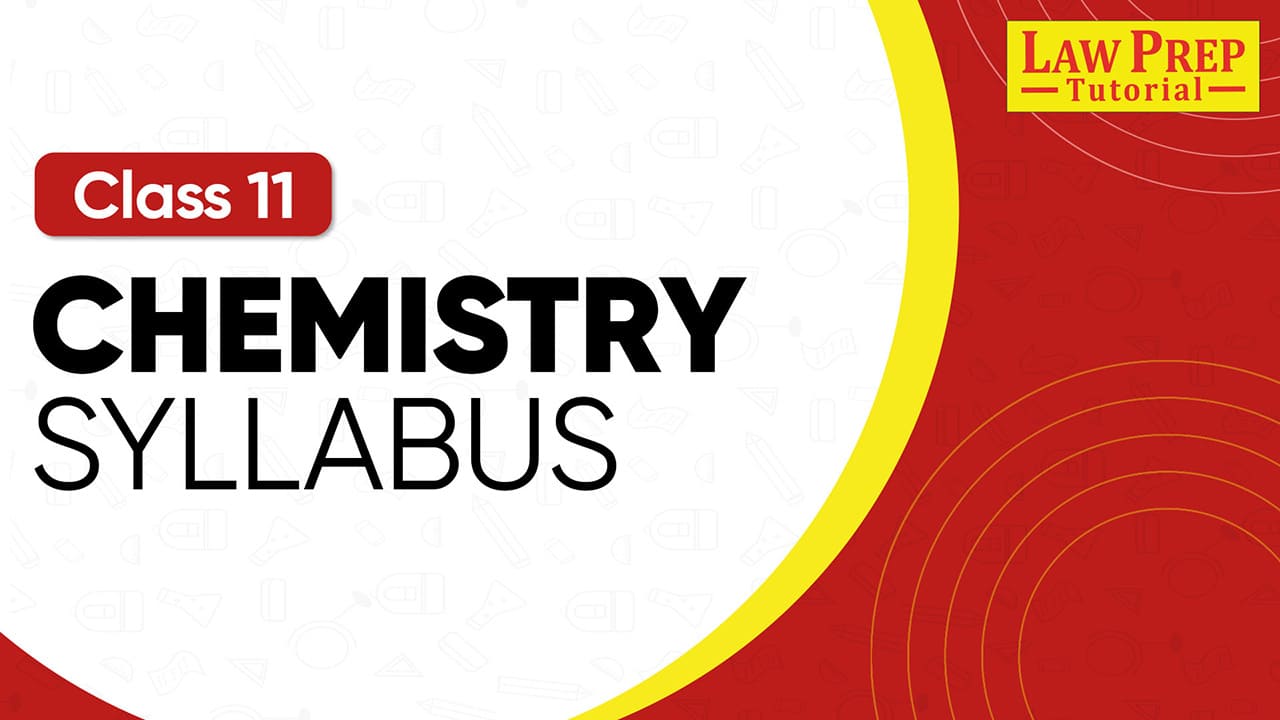Chemistry is a crucial subject in the Science stream, especially for students preparing for careers in engineering, medicine, and research. The Class 11 Chemistry syllabus 2025-26 prescribed by CBSE is designed to give students a strong foundation in chemical concepts, problem-solving skills, and practical applications.
It covers topics like atomic structure, chemical bonding, thermodynamics, equilibrium, redox reactions, hydrocarbons, and more. The syllabus also emphasizes hands-on laboratory work and investigatory projects.
In this blog, you’ll find the complete syllabus of chemistry subject for Class 11th, including unit-wise details, exam pattern, practicals, objectives, preparation tips, and a downloadable PDF.
Class 11 Chemistry Syllabus 2025-26: Overview
Find overview of the 11th class chemistry syllabus for CBSE/NCERT:
| Unit No. | Unit Name | Marks |
| I | Some Basic Concepts of Chemistry | 7 |
| II | Structure of Atom | 9 |
| III | Classification of Elements and Periodicity in Properties | 6 |
| IV | Chemical Bonding and Molecular Structure | 7 |
| V | Chemical Thermodynamics | 9 |
| VI | Equilibrium | 7 |
| VII | Redox Reactions | 4 |
| VIII | Organic Chemistry – Some Basic Principles and Techniques | 11 |
| IX | Hydrocarbons | 10 |
| Total (Theory) | 70 | |
| Practical | Experiments, Salt Analysis, Volumetric Analysis, Project, Viva | 30 |
| Grand Total | 100 |
📥Download Class 11 Chemistry Syllabus PDF
To make your preparation easier, we’ve provided the official CBSE Class 11 Chemistry Syllabus 2025-26 PDF. It includes complete details of theory units, practicals, projects, and exam pattern.
Class 11 Chemistry Syllabus 2025-26
Let’s discuss the chemistry syllabus of class 11th in detail:
Unit I: Some Basic Concepts of Chemistry
The first unit of chemistry syllabus for class 11 introduces the importance and scope of chemistry. Students learn about the nature of matter, laws of chemical combination, Dalton’s atomic theory, mole concept, percentage composition, empirical and molecular formulas, and stoichiometric calculations.
| Topics | Details Covered |
| General Introduction | Importance and scope of chemistry |
| Nature of Matter | States of matter, particles of matter, physical and chemical properties |
| Laws of Chemical Combination | Law of conservation, definite proportion, multiple proportion, Gay Lussac’s law |
| Atomic Theory | Dalton’s atomic theory, concept of atoms and molecules |
| Mole Concept | Atomic & molecular masses, molar mass, Avogadro’s number |
| Calculations | Empirical and molecular formulas, stoichiometry, chemical reactions, percentage composition |
Unit II: Structure of Atom
The second unit of chemistry syllabus of class 11 covers the discovery of subatomic particles, atomic models (Thomson, Rutherford, Bohr), quantum mechanical concepts, dual nature of matter, de Broglie relation, Heisenberg’s uncertainty principle, quantum numbers, orbitals, shapes of orbitals, rules of electron filling (Aufbau, Pauli, Hund), and stability of orbitals.
| Topics | Details Covered |
| Subatomic Particles | Discovery of electron, proton, neutron |
| Atomic Models | Thomson, Rutherford, Bohr models and limitations |
| Quantum Mechanical Concepts | Dual nature of matter & light, de Broglie relation, Heisenberg uncertainty principle |
| Orbitals | Quantum numbers, shapes of s, p, d orbitals |
| Electronic Configuration | Aufbau principle, Pauli exclusion principle, Hund’s rule, stability of orbitals |
Unit III: Classification of Elements and Periodicity in Properties
The third unit in the class XI chemistry syllabus explains the historical development of the periodic table, modern periodic law, and trends in periodic properties such as atomic and ionic radii, ionization enthalpy, electron gain enthalpy, electronegativity, and valency. Also includes nomenclature of elements with atomic numbers greater than 100.
| Topics | Details Covered |
| Periodic Classification | History of periodic table, modern periodic law |
| Periodic Table | Present form of periodic table |
| Periodic Trends | Atomic/ionic radii, ionization enthalpy, electron gain enthalpy, electronegativity, valency |
| Nomenclature | Elements with atomic number > 100 |
Unit IV: Chemical Bonding and Molecular Structure
The 4th unit in CBSE class 11 chemistry syllabus covers valence electrons, ionic and covalent bonds, bond parameters, Lewis structures, resonance, VSEPR theory, hybridization, molecular orbital theory (basic idea), hydrogen bonding, and geometry of molecules.
| Topics | Details Covered |
| Bonding Concepts | Valence electrons, ionic & covalent bonds |
| Bond Properties | Bond length, bond angle, bond enthalpy, polarity |
| Theories | VBT, MO theory (qualitative), resonance |
| Molecular Geometry | VSEPR theory, shapes of molecules |
| Hybridization | sp, sp², sp³ and involving d orbitals |
| Hydrogen Bonding | Types and significance |
Unit V: Chemical Thermodynamics
The fifth unit in the chemistry syllabus of class 11th introduces system and surroundings, types of systems, state functions, first law of thermodynamics, enthalpy, Hess’s law, bond enthalpy, enthalpy of formation/combustion/ionization, entropy, Gibbs free energy, and spontaneity.
| Topics | Details Covered |
| System and Surroundings | Types of systems, state functions |
| First Law | Internal energy, enthalpy, heat capacity, Hess’s law |
| Enthalpy Changes | Bond enthalpy, combustion, formation, atomization, sublimation, ionization |
| Second & Third Laws | Entropy, Gibbs free energy, spontaneity, equilibrium criteria |
Unit VI: Equilibrium
The sixth unit in 11th class chemistry syllabus deals with physical and chemical equilibrium, law of mass action, equilibrium constant, Le Chatelier’s principle, ionic equilibrium, strong and weak electrolytes, degree of ionization, pH concept, hydrolysis, buffer solutions, solubility product, and common ion effect.
| Topics | Details Covered |
| Chemical Equilibrium | Dynamic nature, law of mass action, equilibrium constant |
| Le Chatelier’s Principle | Factors affecting equilibrium |
| Ionic Equilibria | Strong & weak electrolytes, ionization of acids/bases, polybasic acids |
| pH and Buffers | pH concept, hydrolysis of salts, Henderson equation |
| Solubility Product | Common ion effect, applications |
Unit VII: Redox Reactions
The 7th unit in syllabus of chemistry for class 11 introduces oxidation and reduction, redox reactions in terms of electron transfer and oxidation number, balancing of redox reactions, and practical applications.
| Topics | Details Covered |
| Oxidation-Reduction | Concepts of oxidation & reduction |
| Redox Reactions | In terms of electron transfer & oxidation number |
| Balancing | Methods of balancing redox equations |
| Applications | Practical significance of redox reactions |
Unit VIII: Organic Chemistry – Some Basic Principles and Techniques
The eighth unit in the chemistry syllabus for class 11th provides foundation of organic chemistry: purification methods, qualitative and quantitative analysis, IUPAC nomenclature, electronic effects (inductive, resonance, hyperconjugation), bond fission, intermediates (carbocations, carbanions, free radicals), electrophiles and nucleophiles, and types of organic reactions.
| Topics | Details Covered |
| Introduction | Scope and importance of organic chemistry |
| Purification | Methods of purification of organic compounds |
| Analysis | Qualitative and quantitative analysis |
| Nomenclature | Classification & IUPAC rules |
| Electronic Effects | Inductive, electromeric, resonance, hyperconjugation |
| Bond Fission | Homolytic & heterolytic, free radicals, carbocations, carbanions |
| Reaction Types | Electrophiles, nucleophiles, types of organic reactions |
Unit IX: Hydrocarbons
The 9th unit in chemistry syllabus of class 11 covers topics like alkanes, alkenes, aljynes, aromatic hydrocarbons, etc.
| Topics | Details Covered |
| Alkanes | Nomenclature, isomerism, conformations, properties, halogenation, combustion, pyrolysis |
| Alkenes | Structure, geometrical isomerism, preparation, electrophilic addition, peroxide effect, ozonolysis, oxidation |
| Alkynes | Structure, acidic character, preparation, addition reactions |
| Aromatics | Benzene – resonance, aromaticity, electrophilic substitution (nitration, sulphonation, halogenation, Friedel-Crafts), directive influence, carcinogenicity |
More Important Resources for CBSE Exam:
| Class 11th Hornbill Syllabus | CBSE Class 11th Commerce Subjects |
| CBSE Full Form | All about CBSE Class 11th |
| Class 11th Syllabus | Class 12th Syllabus |
| Class 11th Commerce Books | CBSE Board: All details |
CBSE Class 11 Chemistry Syllabus for Practicals (2025-26)
1. Evaluation Scheme
| Component | Marks |
| Volumetric Analysis | 08 |
| Salt Analysis | 08 |
| Content-based Experiment | 06 |
| Project Work | 04 |
| Class Record & Viva Voce | 04 |
| Total | 30 |
2. List of Practicals
A. Basic Laboratory Techniques
- Cutting, bending, drawing out glass tubes, preparing jets.
- Boring a cork.
B. Characterization & Purification of Chemical Substances
- Determination of melting and boiling points of organic compounds.
- Crystallization of impure samples: alum, copper sulphate, benzoic acid.
C. Experiments Based on pH
- Determination of pH of fruit juices, acids, bases, and salts using pH paper/universal indicator.
- Comparing pH of strong and weak acids of same concentration.
- Study of pH change during titration of a strong base with a strong acid.
- Common-ion effect on pH in weak acids and bases.
D. Chemical Equilibrium Experiments
- Study the shift in equilibrium between ferric ions & thiocyanate ions.
- Study equilibrium between [Co(H₂O)₆]²⁺ and chloride ions by changing concentration.
E. Quantitative Estimation (Titrations)
- Preparation of standard solutions (oxalic acid, sodium carbonate).
- Determination of strength of given NaOH solution using oxalic acid.
- Determination of strength of HCl using standard sodium carbonate solution.
F. Qualitative Analysis
- Detection of one anion and one cation in a given salt.
- Cations: Pb²⁺, Cu²⁺, Al³⁺, Fe³⁺, Mn²⁺, Ni²⁺, Zn²⁺, Co²⁺, Ca²⁺, Sr²⁺, Ba²⁺, Mg²⁺, NH₄⁺
- Anions: CO₃²⁻, S²⁻, SO₃²⁻, NO₃⁻, NO₂⁻, Cl⁻, Br⁻, I⁻, SO₄²⁻, PO₄³⁻, CH₃COO⁻
- Detection of nitrogen, sulphur, and halogens in organic compounds.
G. Projects
Some suggested investigatory projects:
- Checking bacterial contamination in drinking water.
- Study of water purification methods.
- Testing hardness and ions in drinking water.
- Foaming capacity of soaps.
- Acidity of different tea leaves or fruit juices.
- Rate of evaporation of liquids.
- Effect of acids and bases on fibres.
Class XI Chemistry Syllabus: Question Paper Design
- Maximum Marks (Theory): 70
- Time: 3 Hours
1. Typology of Questions
| Domain | Description | Marks % | Total Marks |
| Remembering & Understanding | Recall of facts, terms, basic concepts, and simple understanding | 40% | 28 |
| Applying | Apply concepts, solve problems, use rules and principles in new situations | 30% | 21 |
| Analysing, Evaluating & Creating | Break information into parts, make inferences, interpret data, draw conclusions, propose solutions | 30% | 21 |
| Total | – | 100% | 70 |
2. Question Paper Pattern
- No overall choice in the paper.
- 33% internal choice will be provided in all sections.
- Questions will test knowledge, application, and higher-order thinking.
- Includes MCQs, Short Answer, and Long Answer questions.
Prescribed Books for Class 11 Chemistry (2025-26)
CBSE recommends NCERT books as the primary study material. These are sufficient for board exams and also form the base for competitive exams like NEET and JEE.
- Chemistry Part – I, Class XI, NCERT Publication
- Chemistry Part – II, Class XI, NCERT Publication
Manual of Microscale Chemistry Laboratory Kit (for practical work).
Check the latest CBSE Class 11 syllabus for all subjects below:
Objectives of Class 11 Chemistry Syllabus 2025-26
The syllabus of Chemistry at the senior secondary level is designed to:
- Build conceptual foundations of chemistry for higher studies in medicine, engineering, and research.
- Develop problem-solving and analytical skills by applying chemical principles in real-life situations.
- Introduce modern areas of chemistry like green chemistry, biomolecules, and industrial applications.
- Integrate chemistry with other sciences such as physics, biology, and environmental studies.
- Promote experimental skills through laboratory work, investigatory projects, and hands-on learning.
- Encourage scientific curiosity and research orientation among students.
- Prepare students for competitive exams by strengthening fundamentals of physical, organic, and inorganic chemistry.
Tips to Prepare for Class 11 Chemistry Syllabus
1. Start with NCERT as the Base
The NCERT Chemistry textbooks are the backbone of the syllabus. Read every line carefully, highlight definitions, laws, and formulas, and practice all examples and exercises.
2. Focus on Numericals in Physical Chemistry
Units like Mole Concept, Thermodynamics, and Equilibrium involve lots of problem-solving. Practice numerical questions daily to strengthen speed and accuracy.
3. Make Concept Maps for Organic Chemistry
For Organic Chemistry basics, prepare flowcharts of reaction mechanisms, functional groups, and electronic effects. This makes revision faster and clearer.
4. Practice Periodic Trends Regularly
In Inorganic Chemistry, questions often come from periodic trends (ionization enthalpy, atomic size, electronegativity). Prepare summary tables and revise frequently.
5. Revise Diagrams and Structures
Important diagrams like molecular orbital diagrams, hybridization models, and structures of hydrocarbons must be practiced neatly with labels.
6. Balance Theory with Practicals
Practical exams hold 30 marks. Perform titrations, pH experiments, and salt analysis carefully in the lab, and keep your practical record well-maintained.
7. Solve Previous Year Question Papers
Practice past CBSE papers and sample papers. This helps you understand question patterns, marking scheme, and important chapters.
8. Link Preparation with Competitive Exams
If you’re preparing for NEET or JEE, start solving objective-type questions from each chapter along with theory. This ensures dual preparation for boards and entrance exams.
Find detailed questions and answers from all chapters of English Class 11 now:
Class 11 Inorganic Chemistry Syllabus
Below are the class 11th inorganic chemistry chapters:
| Unit No. | Unit Name |
| I | Some Basic Concepts of Chemistry (7 Marks) |
| II | Structure of Atom (9 Marks) |
| III | Classification of Elements & Periodicity (6 Marks) |
| IV | Chemical Bonding & Molecular Structure (7 Marks) |
| V | Chemical Thermodynamics (9 Marks) |
| VI | Equilibrium (7 Marks) |
| VII | Redox Reactions (4 Marks) |
Class 11 Organic Chemistry Syllabus
Below are the class 11th organic chemistry chapters:
| Unit No. | Unit Name |
| VIII | Organic Chemistry – Basic Principles & Techniques (11 Marks) |
| IX | Hydrocarbons (10 Marks) |
Suggested Project Topics for 11th Class Chemistry Syllabus
Students are required to submit one investigatory project as part of their practical work. Here are some interesting and scoring ideas:
- Checking Bacterial Contamination in Drinking Water – by testing sulphide ions or other indicators.
- Study of Methods of Purification of Water – boiling, filtration, chlorination, reverse osmosis, etc.
- Testing Hardness of Water – using soap solution method and suggesting treatment techniques.
- Determination of pH of Fruit Juices/Soft Drinks – and comparing their acidity levels.
- Foaming Capacity of Different Soaps – and the effect of sodium carbonate addition.
- Study of Acidity of Different Tea Leaves – analyzing tannin levels.
- Rate of Evaporation of Liquids – studying effects of temperature, surface area, and airflow.
- Effect of Acids and Bases on Fibres – impact on cotton, wool, and synthetic fibres.
- Comparative Study of Acidity of Fruit and Vegetable Juices.
- Testing the Presence of Common Ions in Drinking Water – such as fluoride, iron, or chloride.
- Study of Corrosion of Metals – factors affecting rusting of iron.
- Investigation of Effect of Temperature on Solubility – of common salts like potassium nitrate.
Read the chapter-wise summaries of Class 11 English here:
FAQs About Class 11th Chemistry Syllabus
There are 9 main units/chapters in Class 11 Chemistry along with some formative topics like Gaseous State and s- & p-Block Elements.
The theory paper is of 70 marks and practicals carry 30 marks, making a total of 100 marks.
Organic Chemistry – Some Basic Principles and Techniques (11 marks) and Hydrocarbons (10 marks) are high-weightage units.
Yes, NCERT is enough for board exams. For JEE/NEET, students can refer to additional practice books.
Students perform volumetric analysis, salt analysis, pH experiments, purification techniques, and equilibrium studies as part of practicals.
One investigatory project is required, such as water purification, foaming capacity of soaps, acidity of juices, or rate of evaporation.
Many students find Structure of Atom, Thermodynamics, and Equilibrium challenging due to numerical and conceptual depth.
Redox Reactions and Some Basic Concepts of Chemistry are usually easier and scoring.
Maintain neat records, practice titration, salt analysis, and perform experiments carefully. Also, prepare well for viva questions.
Not much. The 2025-26 syllabus remains largely the same, with only minor updates.
Yes, nearly 30–35% of NEET Chemistry questions are based on Class 11 topics.
Yes, JEE Main gives significant weightage to Class 11 chapters like Mole Concept, Thermodynamics, Redox, and Equilibrium.
Organic Chemistry basics and Hydrocarbons together carry 21 marks.
Units like Thermodynamics, Equilibrium, and Mole Concept together carry about 30–32 marks.
Units like Classification, Chemical Bonding, and Redox account for about 17–18 marks.
The Mole Concept is covered in Unit I: Some Basic Concepts of Chemistry.
The paper includes MCQs, short answer questions, and long answer questions. There is 33% internal choice in all sections.
Internal marks include projects, practical record, viva, and experiments (30 marks total).
Explore the updated CBSE Class 12 syllabus for all subjects here:
Discover CLAT exam resources that can help you get started early:
Explore CLAT coaching centers across different cities:


